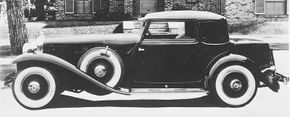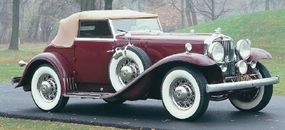The first Stutz built finished eleventh in the first Indianapolis 500 and inspired the slogan "The Car That Made Good in a Day." Stutz was soon building its famous Bearcat and, along with the Mercer Raceabout, introduced America to an early form of the sports car. With big engines and not much bodywork, early Bearcats could easily be taken racing. Both private and factory-backed Bearcats did well in competition and Stutz always traded on a sporting reputation.
Stutz was never a high-volume producer, rising from 266 cars its first full year of production, 1912, to just 2207 in 1917. But the firm was making its own engines by the early '20s: a big 361-cubic-inch side-valve four with 88 brake horsepower and an overhead-valve 75-bhp six. The latter was bumped up to 80 bhp and 268 cid for 1924's Speedway Six. Fours were discontinued the following year.
Advertisement
Stutz design was old-fashioned by the mid 1920s. European-born, Frederick E. Moskovics arrived in 1925 to take over the presidency of Stutz. Moskovics did for Stutz what Zora Arkus-Duntov would later do for Corvette -- add a European influence that improved performance and handling. Moskovics introduced beautiful new open and closed "Safety Stutz" models the following year.
These carried Stutz's first eight, a European-inspired inline engine with single overhead camshaft and dual ignition with two plugs per cylinder. Stutz called it the "Vertical Eight." Bowing at 289 cid and 92 bhp, it would be the heart of all Stutzes through the final 1935 models. The sole exception was the 1929-30 Blackhawk, a companion line powered by an L-head Continental eight or overhead-cam Stutz six. Though "cheap" for Stutz at a base price of $2395, the Blackhawk managed just under 1600 units. After 1930, its chassis was used for the least-costly Stutzes.
The Vertical Eight was quickly uprated, going to 298.6 cid for 1927, then to 322 cid and 113 bhp two years later. Advertised horsepower would go no further, although actual horsepower might have reached 140 by the end of the '20s. Stutz added to its racing image by dominating AAA stock car racing in '27 and giving Bentley a run for its money at the 1928 LeMans. Stutz chassis engineering changed remarkably little after 1929. For example, the same three wheelbases persisted to the end: 134.5 inches, 145, and, after Blackhawk's demise, 127.5 inches.
Though Stutz couldn't afford a 12- or 16-cylinder engine, it did experiment with a supercharger that lifted the Vertical Eight to 143 bhp. The blower was a huge affair mounted low, ahead of the radiator. Like most superchargers, it was driven directly from the crankshaft. It did the job, but it was noisy and carburetion was a problem.
Moskovics left the company in 1929, but some of the greatest Stutzes were still to come. Stutz followed Duesenberg's approach for 1931 by offering a new 32-valve twincam cylinder head. This had no room for the dual ignition of what was now called the "SV16" (single-valve) engine, but improved breathing gave the new "DV32" (dual-valve) 161 bhp at 3900 rpm.
For more on defunct American cars, see:
- AMC
- Duesenberg
- Oldsmobile
- Plymouth
- Studebaker
- Tucker
Advertisement


